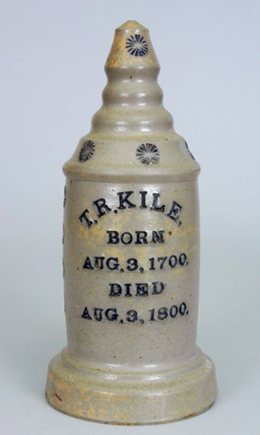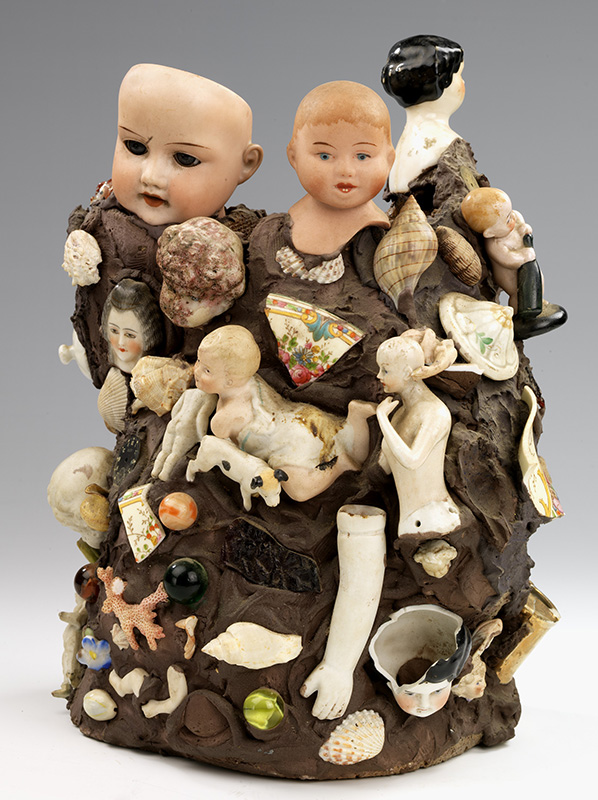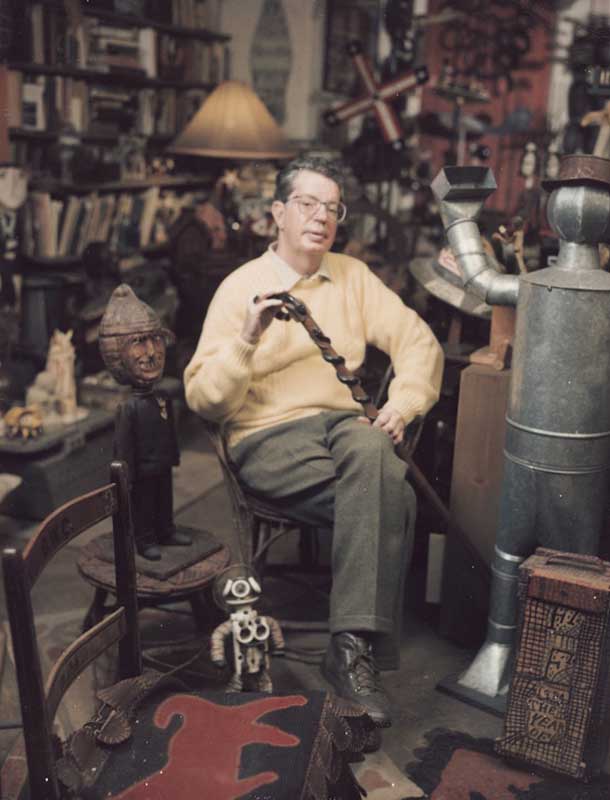Memory Vessels: Folk Art with a Compelling International Origin
by John-Duane Kingsley
As a cultural artifact of the late 19th and early 20th centuries, memory jugs possess an intersectional history as a form of domestic craft with ties to African and African-American burial practices. Traditionally created by the Bakongo people in Central and West Africa as grave markers, memory jugs migrated to the Americas through the importation of slaves and became prevalent in the African-American communities of the South, subsequently merging with the craft pursuits of the Victorian period.1
An examination of Memory Vessel With Encased Photograph (1986.65.308) in the collection of the Smithsonian American Art Museum provides an opportunity to unpack the multitiered cultural influences incorporated into memory jugs. Standing 10 ¼ inches tall and 7 ¼ inches in diameter, the memory vessel was hand-formed by wrapping clay around a metal vessel that provides the shape and supporting structure for the jug. Imbedded into the clay body are mixed media items ranging from a photograph, costume jewelry, commemorative pins, and sea shells. The placement of the central photograph and the beaded spelling of “Adams” along the lip of the vessel served as a scrapbook of the individual’s life.
From the jug’s design and condition we can pose a few deductions. Given the unweathered surface and intact nature of the decoration, the vessel did not likely serve as a grave marker, but instead as a display piece inside the home. The placement of costume jewelry as decorative embellishments suggests the maker may have been a woman, possibly one of the two in the photograph. A commemorative pin with a 1933 date suggests the vessel was created during or after that year. A second pin marked CE St. Paul 1909 provides insight into the Christian faith of the maker. The CE insignia is an emblem for the Young People’s Society for Christian Endeavor, founded in 1881 by Rev. Francis E. Clark as an early form of youth ministry that encouraged virtuous Christian living and actions in daily life.2 The pin’s inclusion on the vessel links the commemorated individual to participation in this movement through presumed attendance at Society’s annual meeting in St. Paul, MN, in 1909.
While the specific decoration of the memory vessel possesses a unique biographical meaning, the cultural origins behind the form and its creative intent originate between the Bankongo region of Central and West Africa and the United States.3 The practice originates in a cultural view of graveyards as a place of commemoration and intersection in which the spirits of the dead may influence the lives of the living if they are not properly commemorated or contained in the spirit realm.4 In the province of Manianga, tombs are elaborately decorated with fragments of objects associated with the deceased, serving as a means for mourners to engage with their deceased loved ones. The broken objects intended as a rupture point between the spirit and their attachment to the object, thereby placating the spirit but also severing their attachment to the object and also the realm of the living.5 Manianga commemorative rituals also include cylindrical jars with swirling inscriptions and signs known as bidimbu that serve to praise and contain the spirit of the deceased.6 With the importation of slaves into the Americas, scholars assert that these distinct traditions blended to form memory vessels that simultaneously housed the spirit, appeased their need for temporal goods, and recalled the domain of the dead through their suggestive decoration.7
These practices adapted into an existing Southern custom of using ceramic grave markers as inexpensive alternatives to stone slab headstones. African-American potters are documented creators of such markers in shapes that recall memory vessels, providing a further foothold for integration into American commemorative and burial objects.8 As a cultural practice, the assemblage of seemingly dissonant elements to form a new creative entity strongly resonates throughout African American culture. This manifests in jazz, folklore, quilt-making, and other practices that embrace improvisation to consciously reflect the multi-dimensional nature of life, death, and memory.9 As these cultural practices assimilated into a popular craft tradition, memory jugs became more sculptural and whimsical.10 This is seen below with Memory Vessel with Doll Parts that embraces improvised sculptural construction over intentional commemoration.
This transition is credited with the late Victorian period’s predilection for scrapbooking and decorating frames, jars, and interiors with eclectic objects.11 These vessels offered intersectional appeal as a synthesis of craft, folk history, and memorials. Their strong appeal for collectors of American folk art ensured their preservation in museums and private collections.
As a donation by respected folk art collector Herbert Waide Hemphill, Jr., Memory Vessel With Encased Photograph possesses cultural significance within the greater patterns of folk life collecting and institutional appreciation of folk art within SAAM and the United States as a whole. Against the tide of traditional collecting that focused on privileged objects made in New England prior to 1900, Hemphill advocated the importance of contemporary folk artisans and their works.12 In 1986, he donated Memory Vessel along with 426 objects from his collection to the Smithsonian Museum of American Art, effectively quadrupling the museum’s holdings of folk art.13 Hemphill’s donation coincided with the decline of Modernism and the rise of cultural anthropology, which provided an opening for folk art to occupy an expanded place within the canon of American art.14
As an object of folk art, memory formation, and intercultural exchange, Memory Vessel with Encased Photograph provides a unique lens into multi-cultural practices of collecting, display, and interpretation from the perspective of graveyard, domestic, and museum environments. Its cross-cultural resonance provides an opportunity to understand how varying societies and individuals, from the people of the Bakongo to preeminent collectors, choose to curate their cultural legacies.
John-Duane Kingsley is a new contributing writer to The Decorative Arts Trust Bulletin. You can read more of his work at www.dandycraft.org.
1 Robert Farris. Thompson, Brooke Davis. Anderson, and Linda Beatrice. Brown, Forget-me-not: The Art & Mystery of Memory Jugs (Winston-Salem, NC: Diggs Gallery at Winston-Salem State University, 1996), 5.
2 Robert Danielson, “The Christian Endeavor Collection – Asbury Theological Seminary,” Asbury Theological Seminary, accessed November 16, 2016, http://asburyseminary.edu/elink/the-christian-endeavor-collection-1/.
3 Robert Farris. Thompson, Brooke Davis. Anderson, and Linda Beatrice. Brown, Forget-me-not: The Art & Mystery of Memory Jugs (Winston-Salem, NC: Diggs Gallery at Winston-Salem State University, 1996), 5.
4 John L. Moore and John Michael Vlach, The Afro-American Tradition in Decorative Arts: Notes on the Exhibition (Cleveland: Cleveland Museum of Art, 1977), 139.
5 Robert Farris. Thompson, Brooke Davis. Anderson, and Linda Beatrice. Brown, Forget-me-not: The Art & Mystery of Memory Jugs, 5.
6 Robert Farris. Thompson, Brooke Davis. Anderson, and Linda Beatrice. Brown, Forget-me-not: The Art & Mystery of Memory Jugs, 5.
7 Robert Farris. Thompson, Brooke Davis. Anderson, and Linda Beatrice. Brown, Forget-me-not: The Art & Mystery of Memory Jugs, 10.
8 Ibid.
9 Robert Farris. Thompson, Brooke Davis. Anderson, and Linda Beatrice. Brown, Forget-me-not: The Art & Mystery of Memory Jugs, 26.
10 Robert Farris. Thompson, Brooke Davis. Anderson, and Linda Beatrice. Brown, Forget-me-not: The Art & Mystery of Memory Jugs, 9.
11 Lynda Roscoe. Hartigan and Andrew L. Connors, Made with Passion (Washington D.C.: National Museum of American Art, 1990), 162.
12 Roberta Smith, “Herbert Waide Hemphill Jr., Folk Art Collector, Dies at 69,” The New York Times, May 12, 1998, accessed November 16, 2016, http://www.nytimes.com/1998/05/13/arts/herbert-waide-hemphill-jr-folk-art-collector-dies-at-69.html.
13 Lynda Roscoe. Hartigan and Andrew L. Connors, Made with Passion (Washington D.C.: National Museum of American Art, 1990), ix.
14 Ibid.
About The Decorative Arts Trust Bulletin
Formerly known as the "blog,” the Bulletin features new research and scholarship, travelogues, book reviews, and museum and gallery exhibitions. The Bulletin complements The Magazine of the Decorative Arts Trust, our biannual members publication.













